There was significant coral bleaching this last summer. It was remarkable at the Keppel Islands. But because scientists have been falsely calling it every year, this important fact is likely to be lost to our collective memory. It is also a problem when my colleagues deny this bleaching.
If we deny when there is bleaching, and claim bleaching when there is none – it is impossible to know the cycles and their causes.
Last Sunday morning, at Secret Cove, I watched the turtle come out from under a stand of stark white coral – bleached coral – and swim towards me.
We swam together for a short while. It looked across at me. I held its gaze. It propelled itself gracefully forward with its fore flippers.
I tried to keep up.
Then the turtle veered off, in a different direction – away from me, and towards more stark white bleached coral.

The turtle was not bothered by me and seemed oblivious to all the coral bleaching.
The creatures under-the-water last Sunday morning, they seem oblivious to the colour of the coral that was mostly stark white, some healthy chocolate brown (replete with symbiotic zooxanthellae/good microalgae), and some brown from infestations of macro algae smothering the corals.

To my eye, the fish and other creatures seemed randomly distributed, which is to say they could be found across the reef irrespective of the colour of the coral.
It was not at all how the BBC have described coral bleaching at the Great Barrier Reef – they have recently been using the terms ‘ghostly white’, ‘spooky white’, ‘like a graveyard’. These journalists are clueless (CLICK HERE).

Secret Cove a week ago was badly bleached – and it was teeming with life. But to know this, it is necessary to get under the water.
A big shout out to Jenn and the rest of the crew at Keppel Dive on Great Keppel Island (CLICK HERE). Thank you for the opportunity to dive so many coral reefs last weekend – thank you for your care and for finding the Epaulette shark at Secret Cove.
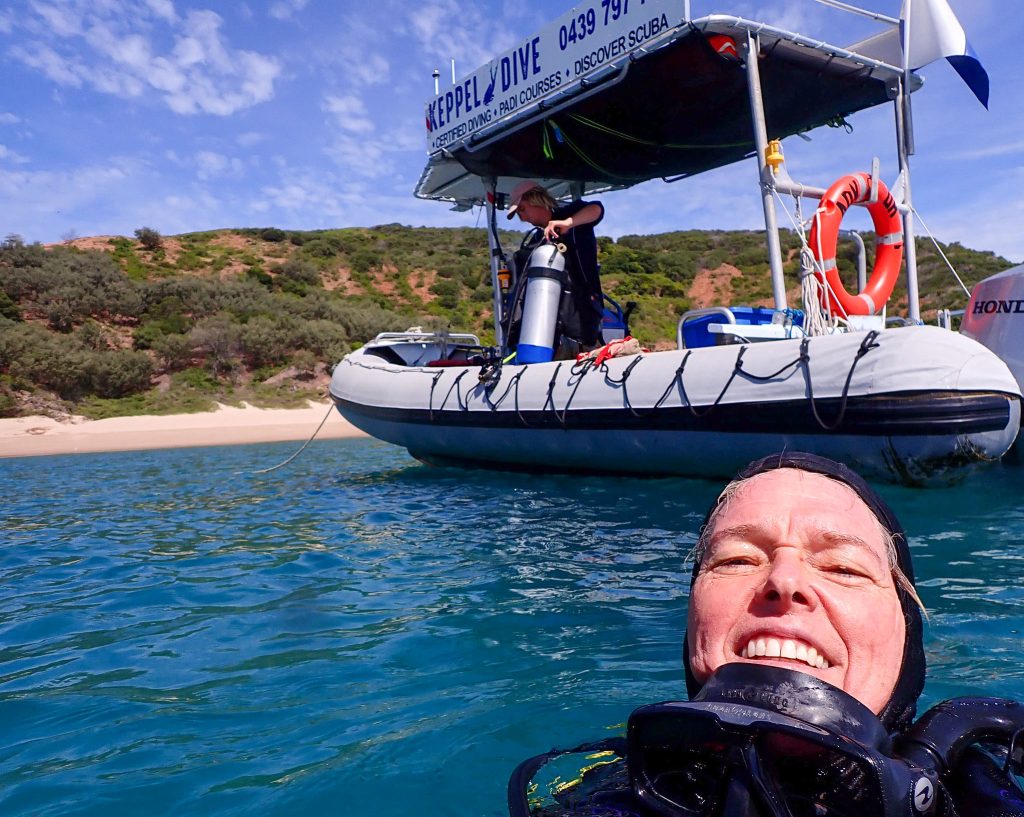
To know that many of the stark white corals are still alive it is necessary to observe them up close. For example, the brain coral (perhaps a Lobophyllia sp. or Caulastrea sp.) did look ‘ghostly white’ from a few metres away. But up close – after I reset my camera to take a macro – you can see that the polyps are still very much intact, that the polyps have a carpet-like texture concealing separate corallites.


We even found a Moray eel. I only managed to photograph its head, after waiting. Its long slender body hidden under the corals.

Secret Cove fringes Great Keppel Island, reportedly with some of the worst of the coral bleaching, considering the entire Great Barrier Reef this last summer.
The BBC also mentioned ocean acidification and high temperatures – unprecedented they claim. Again, they are just making stuff up.
I’ve noticed that the journalists and the scientists, from all sides of the political divides, increasingly just add to the established narratives rather than checking the data, or even visiting a coral reef. This makes me an outlier – relevant only because you are reading me. (For sure the institutions and sometimes even my colleagues and even social media want me cancelled so be sure to subscribe at my website for weekly e-news: CLICK HERE)
It is the case that our oceans are not acidic, not at all. I wrote about this in a chapter for ‘Climate Change, The Facts’ back in 2017 (CLICK HERE).
As for the water temperatures, this last summer was hot, but not exceptionally so.
I write this, not with reference to the wholly contrived coloured maps they show you on the nightly news often for the whole Earth and always showing continuous increase (as though there is never winter), but rather with reference to more reliable location specific temperature data for the Keppel Islands. For example, considering Australian Institute of Marine Science data for Square Rocks, and Bureau of Meteorology data for Rosslyn Bay, we can see that there is still a strong seasonal component to the temperature data and that this last summer temperatures were well within the expected seasonal cycle.
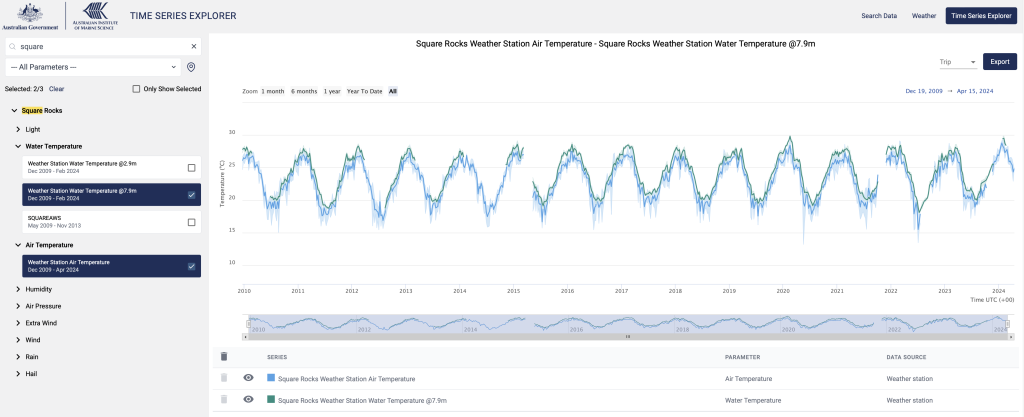
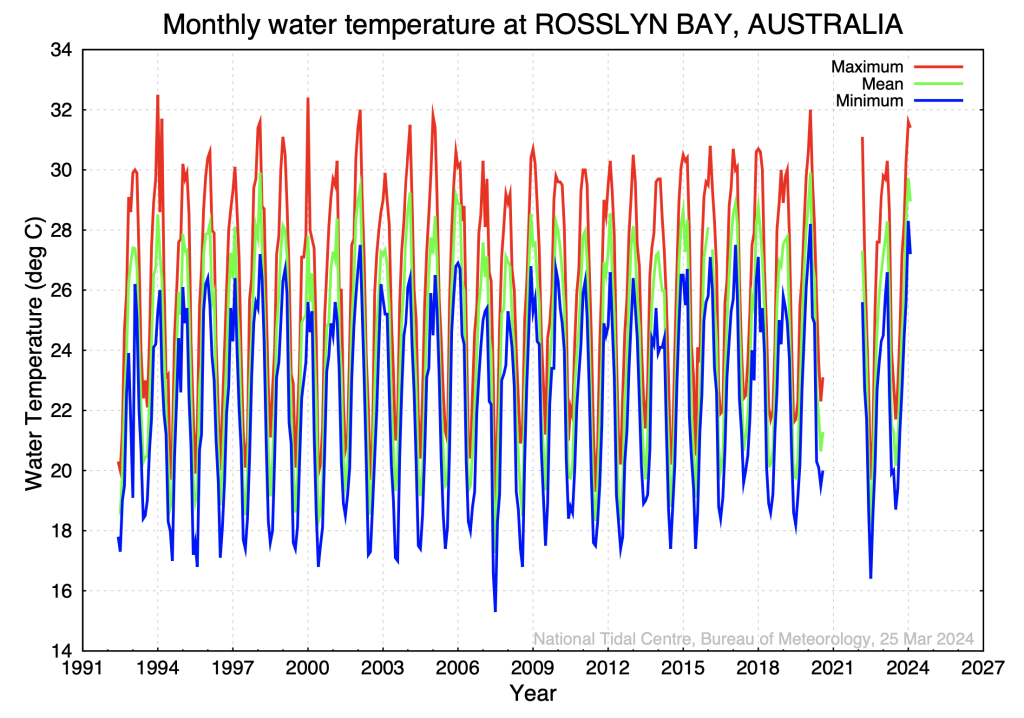
So, what caused the coral bleaching this last summer that has been so severe, particularly at the southern Great Barrier Reef, and particularly at the Keppel Islands?
The Moon has a particular influence on sea levels.
We see this not just in the daily and monthly cycles, but the Moon also causes the less well understood 18.6-year declination cycle.
The Moon takes a month to complete a revolution around the Earth. But it doesn’t follow the same path, moving above the Earth’s equator for two weeks and below the equator for two weeks of each month. The distance above and below the equator changes with this 18.6 year cycle. This is because as the Earth is tilted at 23.5 degrees relative to the Sun causing the seasons, the Moon is tilted at 5 degrees relative to the Earth, and every 18.6 years, the angle between the Moon’s orbit and Earth’s equator reaches a maximum that is the sum of Earth’s equatorial tilt (23°27′) and the Moon’s orbital inclination (5°09′) to the ecliptic. This is called major lunar standstill, and I define it as occurring when the distance that the Moon travels south is more than 28 degrees south each month.
While we may intuitively expect larger sea tides as the Moon approaches its maximum declination considering this 18.6-year cycle, because the gravitational forcing of the Moon is less well aligned with the gravitational forcing of the Sun on the Earth at this time, we see on average lower sea tides at least in the data for the nearby Rosslyn Bay gauge for the last few months.

I suspect that the bleaching at the Keppel Islands this last summer can be blamed on the Moon; specifically that the lower tides caused by Maximum Lunar Declination combined with a short period of clear skies and no winds caused the water to stay continuously warm for a longer period than usual, in a way that was catastrophic.
That is my hypothesis.
The popular claim, the consensus claim consistent with anthropogenic global warming theory that the atmosphere replete with greenhouse gases has been warming the ocean is not credible, at least not considering the location specific data for Square Rocks between North Keppel Island and Great Keppel Island. The available Australian Institute of Marine Science (AIMS) data shows that the water is consistently warmer than the air above it. As the water is consistently warmer than the air, it is not logical to suggest that the air is warming the water.
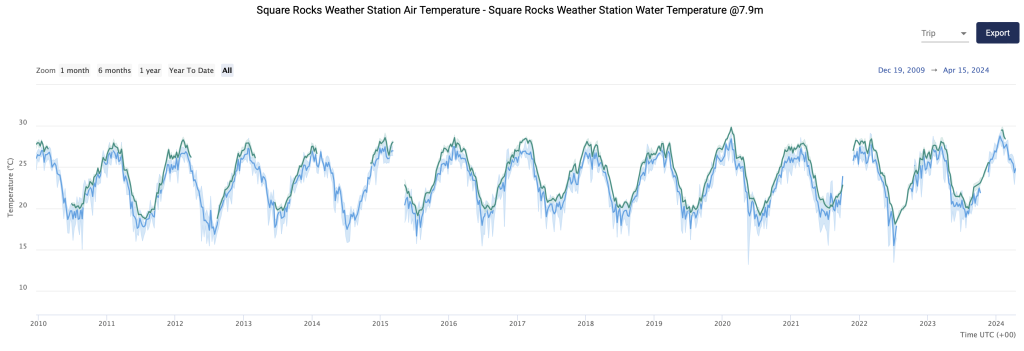
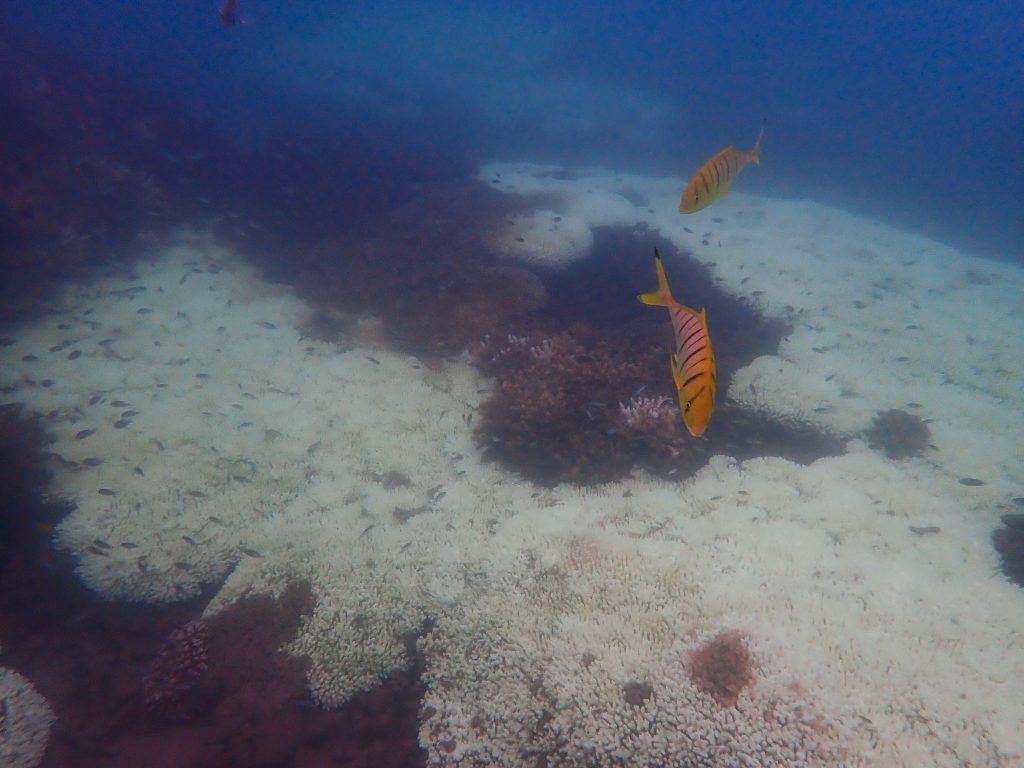
*** Notes/Key References
Dr Alison Jones has been monitoring coral cover across reef flats and slopes in the Keppel Islands for some years. If this work continues, we could know the extent of the recovery in numbers – measured. More information here: Jones & Berkelmans. Keppel Islands reefs: Baseline study 2008-2010. CLICK HERE.
There was significant reporting of coral bleaching at the Keppel Islands in 2006, corresponding with the last maximum lunar declination; more information here: Great Barrier Reef coral bleaching surveys 2006. GBRMPA Research Publication No. 87 CLICK HERE.
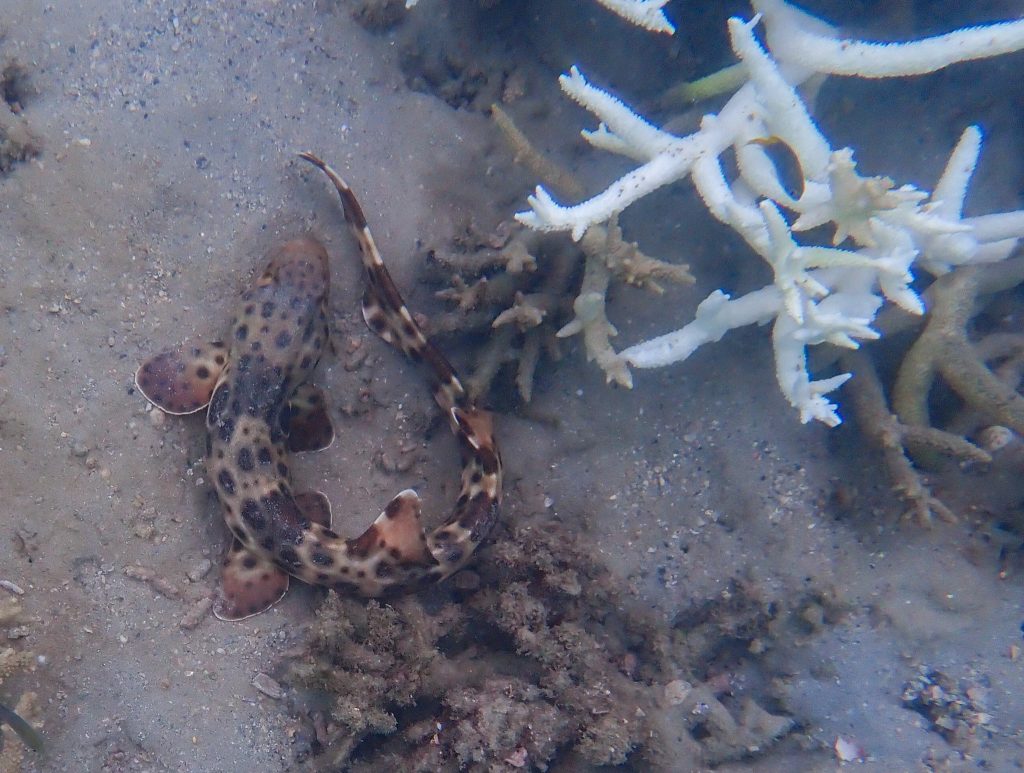
Understanding Lunar Declination …
Today, the Earth’s axis is tilted 23.5 degrees from the plane of its orbit around the sun. But this tilt changes. During a cycle that averages about 40,000 years, the tilt of the axis varies between 22.1 and 24.5 degrees. Because this tilt changes, the seasons as we know them can become exaggerated.
Every 18.6 years, the angle between the Moon’s orbit and Earth’s equator reaches a maximum of 28°36′, the sum of Earth’s equatorial tilt (23°27′) and the Moon’s orbital inclination (5°09′) to the ecliptic. This is called major lunar standstill. Around this time, the Moon’s declination will vary from −28°36′ to +28°36′.
“Because of the inclination of the Moon’s orbit with respect to the Earth’s equator, the Moon is above the horizon at the North and South Pole for almost two weeks every month, even though the Sun is below the horizon for six months at a time. The period from moonrise to moonrise at the poles is a tropical month, about 27.3 days, quite close to the sidereal period. When the Sun is the furthest below the horizon (winter solstice), the Moon will be full when it is at its highest point. When the Moon is in Gemini it will be above the horizon at the North Pole, and when it is in Sagittarius it will be up at the South Pole. Quoting from Wikipedia, CLICK HERE .

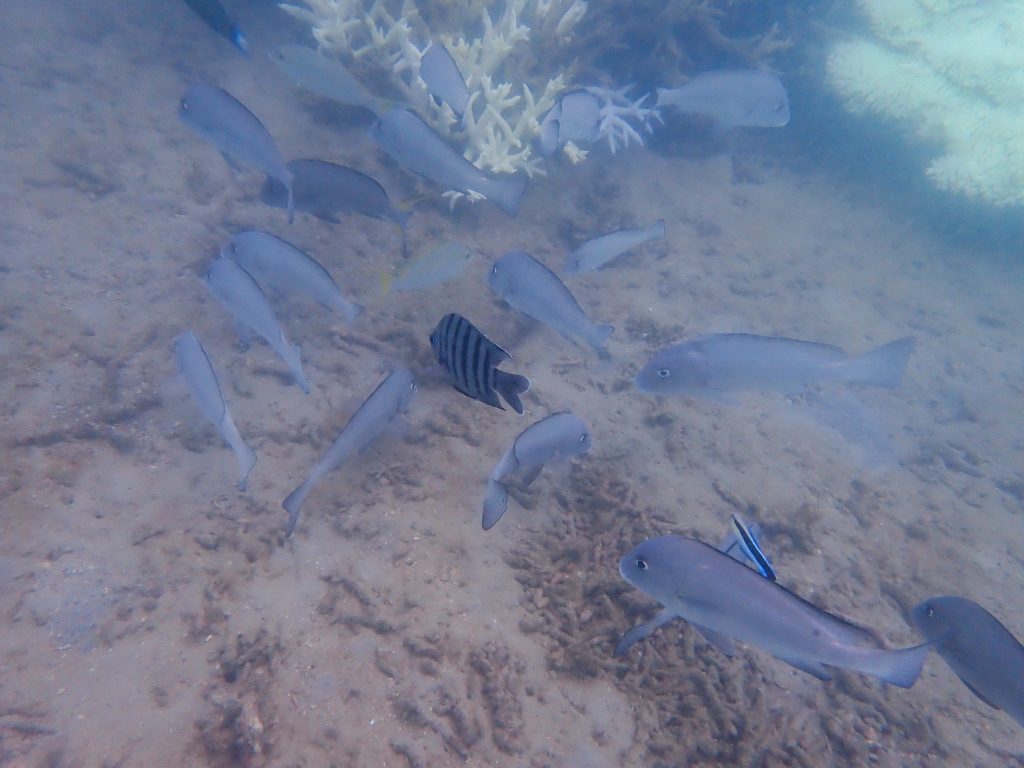
via Jennifer Marohasy
April 28, 2024 at 02:32AM
